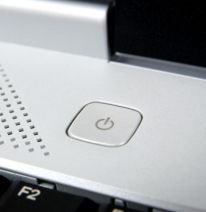 From the outside, your computer looks like a standard piece of office equipment; but on the inside, there are fragile components that make up the hard drive, which means that you should take extra care when moving it.
From the outside, your computer looks like a standard piece of office equipment; but on the inside, there are fragile components that make up the hard drive, which means that you should take extra care when moving it.
You can hear the hum of the hard drive spinning, but do you know what that humming is all about? This hard drive noise is metal platters with data stored on them, spinning at speeds of only 4,000-to-15,000 revolutions per minute, no big deal. For the data to be read, a small head from an actuator arm moves over the spinning platters, kind of like how a record player works. You wouldn’t move a record player while it’s playing music; and in the same way, you shouldn’t jiggle a computer while it’s reading data.
Before you move your computer, it’s best to first turn it off. As long as the machine is powered-on, the hard drive platters are moving at thousands of rpms, and the only time the hard drive takes a break is when it’s turned off. This is why many users prefer to keep their computers always powered-on, because it takes a sizable jolt of electricity to get the platters spinning at such ridiculously fast speeds.
To achieve hard drive speeds this fast, physics come into play and gyroscopic motions are employed. This keeps the tiny hard drive pieces from touching each other; because if the hard drive components touch at these speeds, it will cause serious damage, or worse, a hard drive crash. With everything being this fragile, you can see why it’s so important to backup your hard drive.
One factor that can throw off this precise gyroscopic pattern is movement. This is why it’s a best practice to first turn off your PC or server before moving it for any reason. Movement that is too drastic can cause serious damage if these spinning platters were knocked out of rotation.
Hard drive issues from movement can come from more sources than just improper PC handling. Vibrations can also mess with the hard drive gyroscopic pattern. For the sake of your computer’s health, you need to be aware of how much the world is moving around you. Is your office next to an airport and planes are shaking your building with every takeoff? Do you have a big speaker sitting next to your PC? Or does your company use heavy machinery? All of these factors can wear on your hard drive.
You may think that a computer like a laptop is immune to this movement risk, but if a laptop is using a disc hard drive, instead of an SSD drive with no moving parts, then even a laptop’s drive can be hurt with bad vibrations. Laptops are designed with more support than a desktop PC, but even so, you will still want to use caution when moving a powered-on laptop.
With hard drives and all technology, its best practice to be mindful of how your environment affects your equipment. There are many threats out there; vibrations, dust, faulty electrical wiring, or even food spilt on the keyboard. Sometimes the biggest threat to your PC may not be from hackers, but from your surroundings! If you would like Vantage Point to assess your IT infrastructure and point out the risks, both interior and exterior, then give us a call at 225.242.9309.
Source: vp 300-400

